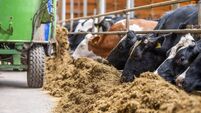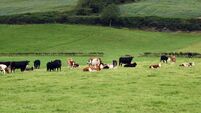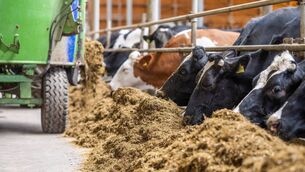Kieran Coughlan: Time to cut the bull on nitrates

No farmer or businessperson wishes to have their livelihood stripped away from them, and farmers are more than willing to play their part in helping the environment, says Kieran Coughlan. File picture
The latest Nitrate Derogation debacle leaves farmers with even more uncertainty than was already the case. For the uninitiated, farmers are limited in the number of animals they can carry per hectare of land. The limit is expressed in what is termed organic nitrogen per hectare.
The standard limit across the country is 170kg of nitrogen per hectare. An average dairy cow produces 92kg of nitrogen, meaning that, absent derogation, a dairy farmer with 100 acres or 40 hectares is limited to carrying about 73 cows.
If you can follow the above calculations, you’re doing well. Now, there are a few complications to throw into the mix.
If your cows are high-yielding cows supplying more than 6,500kg of milk on average, then you’re only allowed to have 64 cows, and if your cows are low-yielding, then you can carry 85 cows. If you apply for a derogation which involves preparing a nutrient management plan and adhering to stricter rules, then you might be able to increase your stocking rate.
Bear with me, there are just a few other issues to consider. Depending on where you are in the country and the nitrate status of your local catchment, there are two higher tiers of stocking rates you might be able to carry. And just to complicate this further, if you are willing to restrict the protein in your herd’s diet at certain times of the year, you might squeeze a little bit more or less out of your stocking rate.
The latest debacle arises as farmers have been blindsided by the layering up of a habitats assessment when considering a farmer's application for derogation to allow them to carry a higher stocking rate, but overall, the local catchment nitrate loading must be factored in, the so-called 220kg/250kg limit depending on your catchment.
Sounds confusing – it is. Sounds like a headache – it is. Sounds like a whole load of rules which ultimately affect a farmer’s business, of which he/she has minimal control - most definitely.
If all the bullshit were stripped away, the fundamental position is that farmers have built up their herds and are running their farms as efficiently as they can based on the resources they have.
The problem with the current rules is that the link between the actions that one farmer takes and the nitrate loading in his or her catchment area is insignificant. There are only 7,000 farmers in the country availing of the nitrates derogation, less than 6% of all farmers.
Whether the nitrate loading in your catchment area is heading in the right direction is dependent on 13 other farmers, but also on non-farming activities, the weather, soil type and a myriad of other factors.
The painful truth, which is not regularly highlighted, is that an estimated 66% of nitrate loss is as a result of urine patches (Reference: Alternative Pasture Management to Address the Nitrates Challenge at the Root Cause, by David Fennelly, 2023 Nuffield Scholar).
Unfortunately, I expect that the water quality reports for Ireland will limp along, hopefully with some improvement. But dairy farmers in particular, who are dependent on the Nitrates Derogation, will face a continual threat of the derogation being removed and yet more regulations to restrict how they operate with very little tangible effects on the nitrate loading within their catchment area despite trojan efforts on farms.
So what options have we as a country? Looking at the issue from a different perspective, the dairy farmers desperately want to hold on to the derogation in order that they can maintain their current stocking rates.
The underlying reason here is that dairy farmers do not want to cut their cow numbers as to do so will result in a direct cut to their profits. Imagine if we as a country redesigned our land policy objectives to support farmers facing this bind, whilst at the same time cutting the bureaucracy and complete nonsense that is building up around keeping the derogation.
The existing land leasing tax exemptions could be tailored overnight such that tax relief is given for share farming operations between tillage and dairy farmers, which results in the dairy farm stocking rate going below the “normal” non-derogation limit.
Farmers who de-stock to come below the 170kg limit could be given a one-off exemption from income tax on the sales proceeds of animals to assist those looking to transition.
Farmers who import slurry could be granted an income tax exemption for payments from dairy farmers, where as a result of the importation of slurry, the dairy farmer's stocking rate falls below 170kg/ha. The leased land exemption was originally introduced to support farmers looking to expand their businesses, whilst encouraging older farmers to step aside.
The leased land exemption has expanded hugely over the years, widening in scope and in terms of the amount of income that can be sheltered by the relief. Is the leased land exemption, as it currently stands, fit for purpose?
I’d bet most dairy farmers would be happy to stick with their current overall cow numbers and keep below the maximum organic nitrogen levels if they were able to purchase land or access rented land at affordable rates.
The plight of dairy farmers affects other farmers too, with the tillage farmer possibly being the most vulnerable.
A redesign of Ireland’s land ownership policy badly needs to take place such that productive and progressive farmers can find a way to secure their livelihoods without the now constant threat of either failing to secure a derogation at national or at a personal level or of losing leased or rented ground as farmer is pitted against farmer in the scramble to secure a sufficient land base. All the while non-active landowners gain from higher rents and land prices as a result.
Will the departments of finance and agriculture come up with innovative solutions instead of simply limping along? Here’s hoping.













